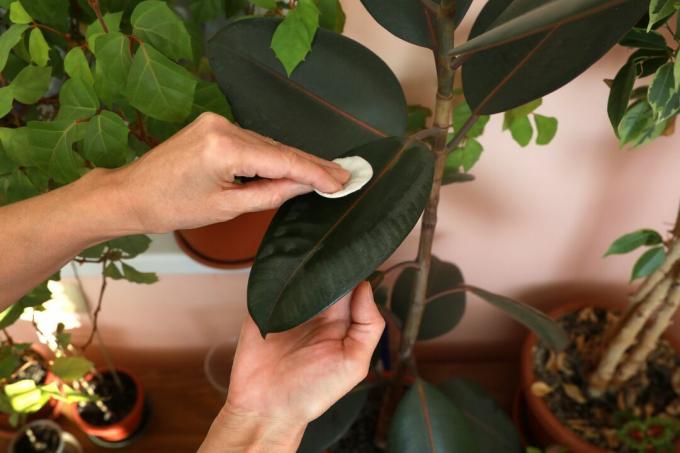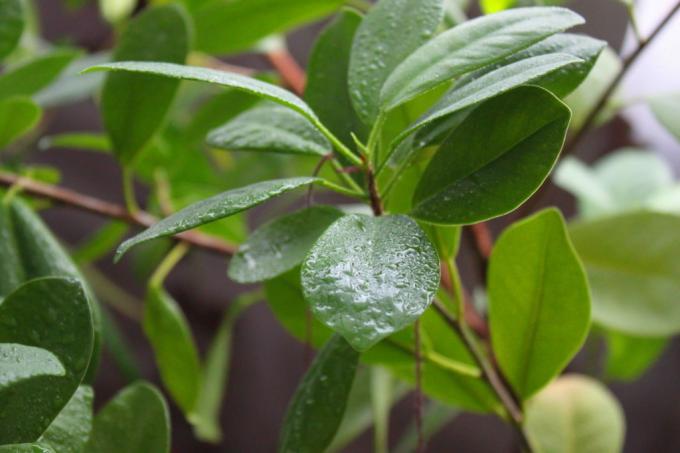With the right care you can enjoy your rubber tree for many years. We show what you should pay attention to when watering, fertilizing and cutting.

Of the Rubber tree (Ficus elastica) is a popular houseplant. This is of course due to its dense, evergreen leaves, but also because it is very easy to care for. Proper care will thank you your rubber tree all the more with its lush growth and a long life. So that you know what to look out for when caring for rubber trees, we have summarized everything about the correct watering, fertilizing and cutting of rubber trees.
The rubber tree is a plant of the fig genus (Ficus). Unfortunately, you can wait in vain for this delicacy by the rubber tree in your room, because the small fruits of the houseplant are inedible. The lush, dense leaves are particularly decorative and the rubber tree is used as an ornament in the home or office.
In order for the rubber tree to look particularly beautiful, it needs a little attention from time to time. Apart from watering, fertilizing and cutting, it is the special leaves of the tree that require your attention. Don't let your rubber tree turn into a dust catcher. The plant's large, broad leaves are unfortunately an ideal place to collect dust. So if you want to do something good for your rubber tree, take a damp cloth and wipe the leaves with it. If that's too much work for you, you can simply give the rubber tree a cold shower. He'll thank you for it and look a lot more attractive again.
Watering rubber tree
The rubber tree does not like wet feet. If it is too damp for him, he sheds his leaves. Therefore, it is best to only water it when the upper substrate has already dried. To determine this, you can perform the finger test. To do this, the finger is inserted into the substrate. When the top inches feel dry, it's time to water. The best way to do this is to use lukewarm, stale water. Five minutes after watering, you can remove excess water from the planter. So there is no waterlogging and no lack of oxygen for the roots or even root rot.
Another way to water the rubber tree is to submerge it. To do this, put the ball of the pot in a bucket of lukewarm water for a few minutes. This allows the root ball to soak up well with water. The rubber tree remains in the water until no more air bubbles rise.

Watering rubber tree summary:
- Check the substrate with a finger sample
- Let the top substrate layer dry
- Pour moderately
- Use lukewarm, stale water
- Remove excess water from the coaster
- Alternatively, water by diving
Fertilize rubber tree
The rubber tree is very frugal when it comes to fertilization. You should therefore not fertilize it too often. It is enough for him if he is given a liquid fertilizer every six weeks. It is even better to use a fertilizer with a long-term effect. Here one fertilization every three months is sufficient. But not only that you have to fertilize less often with a long-term fertilizer - if it is a fertilizer with an organic long-term effect, it is also even more environmentally friendly. Our Plantura organic universal fertilizer With an organic long-term effect, your rubber tree is optimally supplied with all the important nutrients and also consists exclusively of natural raw materials.
Summary of fertilizing rubber tree:
- Do not fertilize too much
- Ideally every 3 months with fertilizer with organic long-term effects
- Alternatively every 6 weeks with liquid fertilizer
Cut rubber tree
You can do a lot with one cut on your rubber tree: you can curb growth, encourage growth or bring the tree into the right shape. The most important thing here is to use clean tools - a sharp knife or secateurs. In addition, when the tree is cut, milky, sticky sap emerges from the interfaces. It is therefore important to take good care of the wounds and cut the tree at the right time. In winter and in the evening the flow of the sap is less. You can dab the cuts on the tree with a damp cloth or sprinkle with lukewarm water.
Summary of cutting rubber tree:
- To contain the growth, shorten the entire crown
- To encourage side shoots, cut the trunk above the "sleeping eyes"
- Cut off side shoots for upright growth
- Immediately remove dried, dead and disease or pest-infected parts of the plant
- nurse wounds
Detailed instructions and lots of tips on how to Cutting your rubber tree can be found here in our special article on the subject.



